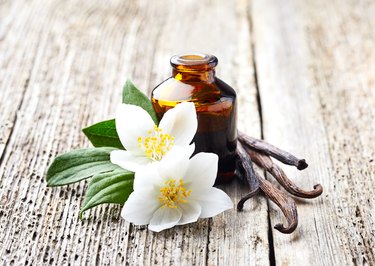
What plant does vanilla come from? The vanilla that we eat is the vanilla bean pod and seeds from the vanilla orchid (Vanilla planifolia). Cultivating this orchid and preparing the bean pods takes a long time, and it is quite labor intensive, which means that real vanilla is not as common as the popularity of the flavor may lead you to believe.
Cultivating Vanilla Orchids
Video of the Day
Where does the vanilla bean come from? Vanilla orchids grow as vines, and they are cultivated in many areas around the world, including Madagascar, Indonesia, Tahiti and Mexico. The flavoring of the beans can vary by region. The vines can attach to trees and produce flowers that each last for a single day. While the flowers are self-fertile, they need help from bees in the wild to pollinate them. However, to ensure a good crop, hand pollination is necessary.
Video of the Day
Mature plants produce green vanilla pods from pollinated flowers. What does a vanilla bean look like? The pods look like small green bananas on the vine, barely resembling the thin, dark brown beans that they become after the curing process. It takes about nine months for the pods to mature and be ready for harvesting.
Curing a Vanilla Bean Pod
Freshly harvested vanilla beans are edible but tasteless. Growers must further process the beans to bring out the vanilla flavor and aroma. After harvesting, the beans are blanched and then sweated for up to 48 hours. Then, the beans are further cured. This process includes sweating at night and drying in the sun during the day for five to 15 days. Finally, the beans are dried in racks indoors for up to 30 days.
Vanilla Extract and Flavor
When many home chefs cook with vanilla, they use vanilla extract, a dark-colored liquid that often has fragments of seeds still left in the extract. However, much of the extract sold in stores and used commercially is artificial or imitation vanilla flavoring due to the high cost of pure vanilla.
Artificial vanilla contains vanillin, the compound in real vanilla. The compound is synthesized or extracted from other sources. Vanillin can come from lignin, a compound found in wood pulp and other plant material, or guaiacol from petrochemicals. While chemically the artificial vanilla is nearly the same, it often lacks the depth of flavor you get from pure vanilla.
If the extract is labeled as a natural flavor, it should come from a plant source. However, if the artificial flavor is not labeled as natural, other sources may have been used to synthesize the vanillin.
Cooking With Vanilla
When you want to splurge, you can purchase vanilla beans and use them and the vanilla bean seeds inside when you are cooking. You can find many tasty recipes, such as vanilla bean pudding or homemade ice cream. You can even add a bit to your coffee or tea. Simply slice open the bean pod end to end with a sharp knife. Open the pod and scrape the seeds from the inside of the pods.